“Why now?” What message moves executive buyers to act?
14th December 2017 | Tim Riesterer
New research reveals the most effective story for making a breakthrough business case to executive-level buyers.

In the previous issue of the Journal, I laid out why there’s serious urgency around salespeople needing to become better at making a compelling business case that moves executive-level decision-makers to buy now. I discussed how business proposals need to become more executive-relevant – that is, more suited to the needs and standards of executive and financial buyers, who might not care so much how your products and services work, but instead want to know how you can help them drive business and performance value.
Finally, and most importantly, I made the case that this topic – what I call the “why now” moment – is so critical to closing more deals in less time that it needs to be addressed by original, first-party research; and this research needs to get to the heart of a question so critical to sales success: what kind of message actually moves executive-level buyers to act now instead of never? In other words, what gets them to decide instead of defer?
That research is now complete, and it’s covered below in full.
What’s ailing business proposals?
The urgency I ascribed to the “why now” conversation in part one of this series has since been further validated by findings from a survey my company conducted about how well – or not – salespeople are performing in some of the key competencies needed to engage executive buyers. The survey of 277 marketing and sales leaders identified that:
- only 39 percent of companies are confident in their ability to build a meaningful business and financial case to justify a decision;
- more than two-thirds of companies say they’re underperforming at getting executive-level prospects to buy now rather than later; and
- 56 percent feel they are “50:50” or worse when it comes to connecting business value to executive-level needs and initiatives.
Basically, if there was any doubt that it was time to conduct some research exploring what it takes to make an effective executive-level business case, these findings put those doubts to rest.
There’s serious urgency around salespeople needing to become better at making a compelling business case that moves executive-level decision-makers to buy now.
Researching the “why now” moment
It has to be mentioned that the forerunner to the “why now” study – and a major inspiration for the follow-up research – was a study we published last year, which we called “executive emotions”. The big takeaway from this research, in summary form, is that – contrary to popular belief – executives are far more swayed by emotional decision-making factors than you might be inclined to think. In fact, that research simulation of executive decision-makers revealed that executives are more than 70 percent more likely to make a risky decision – such as leaving their status quo situation – when that status quo situation is framed in terms of what they might lose by not switching versus what they might gain by following through with a change.
To create the study, the research team from my company, Corporate Visions, collaborated with Dr Nick Lee, Professor of Marketing at Warwick Business School in Coventry, UK.
We designed the test conditions and questions to assess several areas critical to the “why now” moment: areas including confidence in the business proposal, how urgent it was, how essential to future growth, and to what extent it made executives in the study more or less likely to purchase right now. The study, conducted online, included 312 executive participants, all employed at companies with $100 million or more in revenues, and all with budget and decision-making responsibilities.
The highest-performing “why now” message condition appears to provide the biggest edge in the two most important areas.
We then asked all executive participants to imagine they were part of the following business scenario:
“You are an executive at a food-processing company that cleans, sorts and packages vegetables. You have traditionally served large vegetable products using large-scale equipment that can process several tons of vegetables per hour. However, the most promising growth market is organic and specialty food production, and unfortunately, you do not have equipment suitable for the small batch requirements of this ‘small-producer’ market. You will be meeting with a company that makes smaller-scale, more flexible equipment that could help you enter this new market, and they present the following story as to why you should buy their equipment.”
We then split the participants into six different groups of roughly equal size. Each group then experienced a different messaging test condition, or pitch, that contained different elements of the following:
- Business issue: External factors and business initiatives
- Loss: Details about your loss to be avoided
- Gain: Details about your potential positive gain
- Unconsidered needs: Introduces an unsuspected threat
- Heavy ROI: Hard numbers with a detailed ROI breakdown
- Change story: Business change story with a light ROI component
We then asked all participants the following set of questions about the message condition they experienced, to which they were then asked to assign a numerical rating, between one and nine, based on how impactful they believed the message was in each area (one represented the least impactful end of the spectrum, while nine represented the most). Questions included:
- How confident are you that this is a good business decision?
- How convincing was the business case as far as getting you to make a decision soon rather than later?
- How important is the solution for future success and growth?
- How urgent is the need to purchase?
- How likely are you to purchase right now?
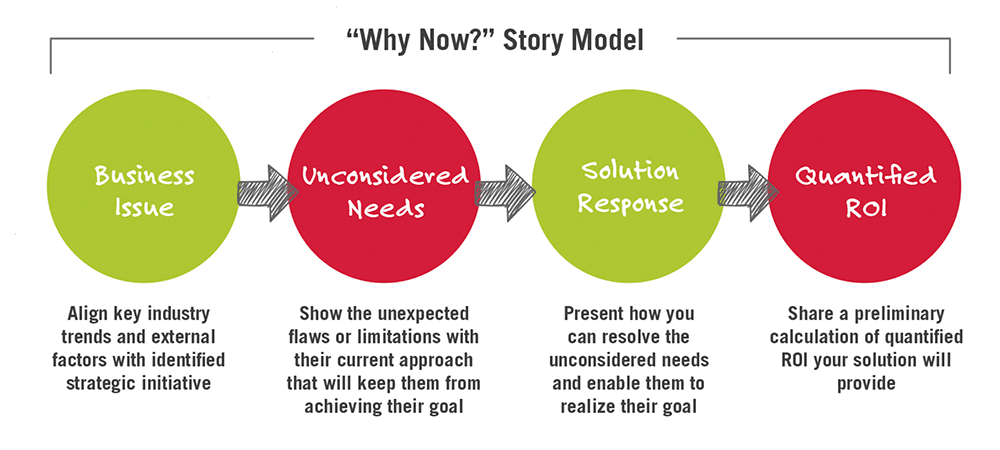
Figure 1: The “Why now?” story model.
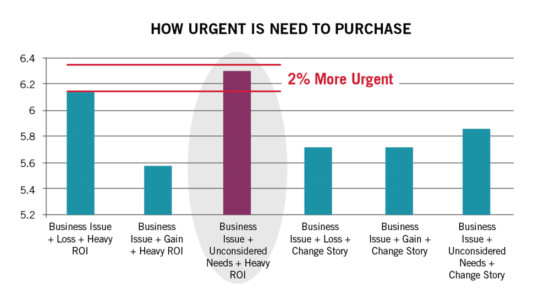
Figure 2: Urgency of need to purchase.
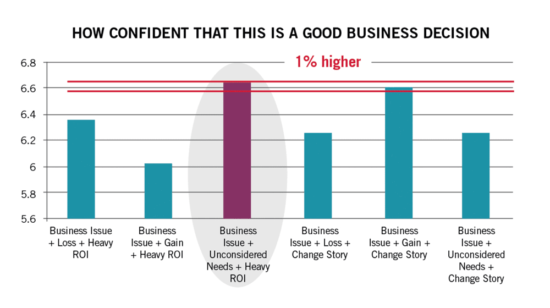
Figure 3: Confidence this is a good business decision.
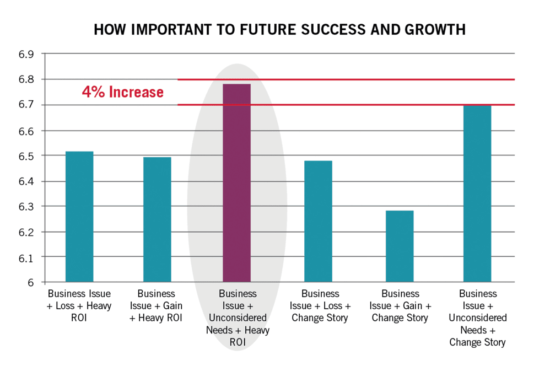
Figure 4: Importance to future success and growth.
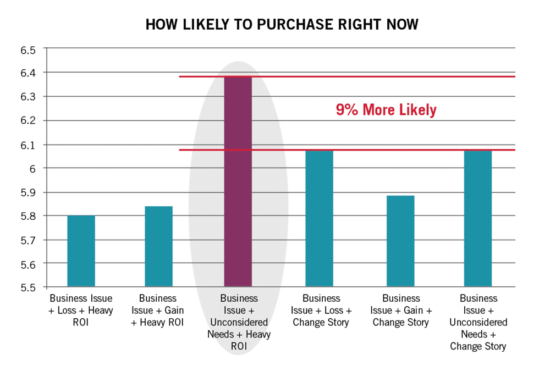
Figure 5: Likelihood of purchasing now.
Results
So, what did the research reveal? Most crucially, it found that the only condition to finish first in each assessed area was the message based on the following structure (Figure 1):
- Present a business issue rooted in external trends and factors the executive will identify with and connect back to their strategic initiatives.
- Introduce “unconsidered needs” – that is, unforeseen problems, challenges or missed opportunities your prospect has underappreciated or doesn’t yet know about that create flaws or limitations in their current approach.
- Provide a solution story that demonstrates specifically how you can resolve the unconsidered needs you identified and enable them to realize their goals.
- Quantify business impact by sharing a preliminary calculation of how your solution can positively influence revenues, cost savings, and operating margin.
Importantly, the five other message conditions included in the test proved highly volatile in terms of how they performed across the assessment areas. (For instance, the message that might have finished second best in one area could have slipped to fourth or fifth in another.) Only the formula structured around presenting a business issue and introducing unconsidered needs before providing a heavy ROI justification consistently performed the highest against all key questions.
It’s also worth mentioning that the highest-performing “why now” message condition appears to provide the biggest edge in the two most important areas for the purposes of this study: 1) importance to future success and growth, for which it provides a 4% edge (Figure 4); and 2) likelihood of making a purchase decision right now, for which companies can gain a 9% advantage (Figure 5).
The relative effectiveness of the message structured around a business issue, an unconsidered need, and a solution response plus a business impact story is consistent with the body of decision-making science research that inspired the study: specifically prospect theory and the related principle of loss aversion. In fact, the middle portion of the message – the unconsidered need – can be interpreted as an extreme form of loss aversion, because it positions their current approach as a loss to be avoided. This satisfies what neuroscientists have identified as the emotional part of the brain, which has been proven to govern the majority of the decision-making process.
Meanwhile, the documented ROI component is suited to appeal to the capacities of the more analytical part of the brain, which is more involved in the rationalization and justification for a decision, and less in the actual decision-making itself.
Conclusion
Stalled proposals, lagging deal momentum and the dreaded “no decision” can be reduced as threats by using this messaging framework to inform your conversations with executive prospects. At minimum, it will ensure you’re applying some research-backed rigour to this critical “why now” moment – where your proposals live and die by your ability to create enough urgency and show clear business and performance impact. The sales teams that can develop and refine the messaging and delivery skills needed to control this moment will be best positioned to have breakthrough, revenue-driving conversations with executive and financial decision-makers.

Dr Nick Lee, Professor, Warwick Business School
Dr Nick Lee, Professor of Marketing, Warwick Business School
“The consistent pattern of a large number of small effects means that, taken together, there is a clear and compelling argument that the business issue – unconsidered needs – heavy ROI message is more likely to be effective than the others. A message that follows this framework, which outperformed all other conditions in the study in the most critical areas of assessment, is the way to go if you’re trying to create the urgency to buy now and demonstrate business impact in your proposals.
The most effective “why now” message framework
Below is an example of the “why now” message that performed best across the key executive decision-making areas assessed in the study:
Business issue: “Growing consumer demand for organic foods, especially in the ‘ready-to-eat’ category presents a great opportunity for processors, like you, to expand.”
Unconsidered needs: “However, this market has unique requirements and cost pressures that you need to consider if you want to enter and compete effectively. First, your large processing machinery is not compatible with the unique needs of the organic producer, who requires frequent changes to accommodate a greater variety of vegetables to be processed, and smaller batch sizes. Second, your current labour and material costs are too high to be price competitive in this market.”
Solution story plus business impact: “Investing in our smaller-scale, flexible equipment should position you to get at least a 1% share of the growing small-producer market, generating $10 million in new revenue. Improvements in automation technology should also provide you with a 2% saving in labour and material costs. This 1% increase in sales and 2% cost savings should improve your operating margin by 29%.
“With all these factors considered, we estimate this will generate an ROI of 78% in your first year of investing in our new smaller-scale processing equipment that will enable you to enter the organic produce market. This means you’ll be making money on this equipment by year two. These results are typical of the results documented by dozens of other processing companies using our equipment.”



